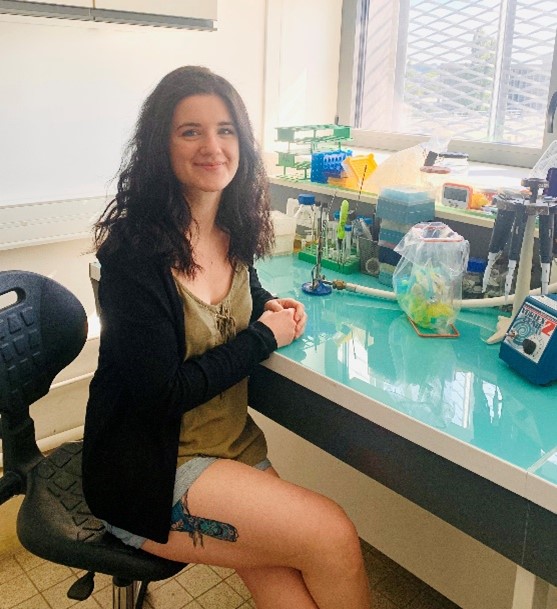Allele differences in the sRNA arcZ gene result in variant prokaryotic and eukaryotic antimicrobial activities of Dickeya solani against bacteria, yeast and fungi.
Speaker: dr Erwan Gueguen, University of Lyon, Laboratory MAP CNRS UMR5240
Talk: "Allele differences in the sRNA arcZ gene result in variant prokaryotic and eukaryotic antimicrobial activities of Dickeya solani against bacteria, yeast and fungi."
Time: 14.10.2022, 9:00 am
Venue: Intercollegiate Faculty of Biotechnology, Abrahama 58, hall 042
 Abstract:
Abstract:
The necrotrophic plant pathogenic bacterium Dickeya solani is an invader of the potato agrosystem in Europe. All isolated strains of D. solani contain several large polyketide/fatty acid/non-ribosomal peptide synthetase clusters. Analogy with genes described in other bacteria suggests that two clusters are involved in the production of secondary metabolites of the oocydin and zeamine families. A 3rd cluster that we named ssm for Solani secondary metabolite had an unknown function. In this study, we used a reverse genetics strategy to create mutants impacted in the three secondary metabolite clusters ssm, ooc, and zms to compare the phenotype of the D. solani strain D s0432-1 with its associated mutants. We demonstrated the antimicrobial functions of these three PKS/NRPS clusters against, yeasts and fungi of the phylum Ascomycota. We unveiled the function of the new secondary metabolite cluster ssm (for solani secondary metabolite), only conserved in some Dickeya species, which produces a secondary metabolite inhibiting yeasts. Finally, phenotyping and small-scale comparative genomic of WT isogenic D. solani strains led us to the discovery that the sRNA ArcZ plays a primary role in the control of the three PKS/NRPS clusters ssm, ooc and zms.
CV of Erwan Gueguen:
Erwan Gueguen received his PhD in molecular microbiology from Paul Sabatier University in 2006, where he explored the transposition mechanism of the mobile genetic element IS911. He completed his postdoctoral training in two distinct labs. From 2007 to 2010, he worked in Andrew Darwin's laboratory at New York University, where he studied the Psp stress response system of Yersinia enterocolitica, and from 2010 to 2012, he worked in Eric Cascales' lab at CNRS in Marseille, France, where he studied the type 6 secretion systems of bacteria in the genus Yersinia and Citrobacter. In 2012, he was hired as a permanent researcher and lecturer at the University of Lyon (France) to investigate first the resistance of bacteria to heavy metals and then the mechanism of plant infection by bacteria of the genus Dickeya. Erwan Gueguen is a bacterial genetics expert. He recently developed the high-throughput transposon sequencing approach for the bacterium Dickeya dandatii and cooperated on its application in D. solani and Xanthomonas hortorum. He recently became interested in the bacterium Dickeya solani, a very aggressive pathogen of potato agrosystem. Dr Gueguen is also very involved in teaching. He is the head of the microbial genetics teaching team and the head of the microbiology program for the life sciences degree at the Claude Bernard University in Lyon.
A short presentation of Typhaine Brual, a PhD student of Dr. Erwan Gueguen will follow the talk of Dr. Gueguen
 Abstract:
Abstract:
Regulation of the virulence of pectinolytic bacteria by RsmC protein
Pectinolytic bacteria are responsible for soft rot disease in plants. At the beginning of the infection, these bacteria multiply while evading the plant's immune system. When they are in sufficient numbers, they produce enzymes such as pectinases to digest the plant cell wall[1]. The timing of the onset of pectinases secretion is decisive and is finely regulated: if it occurs too early, the infection is not efficient. Motility is also crucial for host colonization an immobile mutant does not cause symptoms. The flagellum is also a target of the plant immune system, so its synthesis is highly controlled. Deciphering these regulatory mechanisms is important for understanding the development of virulence in these bacteria. A previous work from my laboratory showed that a protein named RsmC would play a role in the control of virulence in Dickeya dadantii, a model organism of pectinolytic bacteria[2]. The rsmC gene is conserved only in Pectobacteriaceae and has been poorly studied.The structure of RsmC is unknown and only one study describes this protein as an "anti-FlhDC protein", i.e. a repressor of the FlhDC regulator, a complex regulating both motility and secretion of pectinases[3].
The objective of my work is to understand the role of RsmC in the regulation of virulence in D. dadantii using two approaches: 1) Defining the interactome of RsmC, to understand by which intermediary this protein exerts its function; 2) Deciphering the expression conditions of the rsmC gene to study when and how RsmC intervenes in the life cycle of D. dadantii.
[1] Hugouvieux-Cotte-Pattat N. et al., 2020. eLS John Wiley & Sons, Ltd : Chichester
[2] Royet K. et al., 2019. Molecular Plant Pathology, 20,287-306.
[3] Chatterjee A. et al., 2009. Journal of Bacteriology, 191, 4582-4593.





